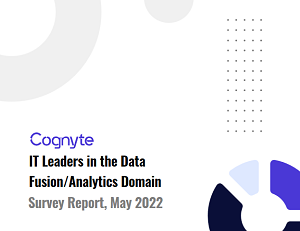Governmental organizations face a growing challenge in generating actionable insights from large volumes of scattered data. As global leaders in investigative analytics, we understand that the right data allows investigators and analysts to answer time-sensitive questions, and critically – to fill the gaps and get the answer to the biggest question of all, “What am I missing?” Without the ability to tag, sift, filter and analyze a growing wealth of data at speed, and to connect the dots from one source to another – organizations will drown in the sheer volume of data and manual work involved.
To get greater insight into the technological challenges of fusing data for investigation purposes, and to learn from the CIO’s perspective what their wants and needs are in the market – our friends over at Cognyte went straight to the source. By speaking to 200 CIOs, CTOs, IT Directors, Directors of Technology and Heads of Artificial Intelligence, this new report “Survey on Data Fusion & Analytics for Investigation” takes the pulse of the industry in vital areas from investment priorities to cloud adoption, painting a clear picture of the state of data fusion for investigation purposes today.
Here’s a short overview of the survey:
- Governmental organizations around the world, especially those needing to investigate various types of digital, financial, and other crime, are challenged in generating actionable insights from large volumes of scattered data.
- The survey results reveal the current state of data fusion for investigation purposes, providing insights on the growing volumes, sources and types of data, data fusion challenges, Machine Learning, investment priorities, and cloud adoption.
- Responses to the survey are from 200 CIOs, CTOs, IT Directors, Directors of Technology and Heads of Artificial Intelligence working at companies including federal and state organizations (focusing on law enforcement agencies at federal and state level), financial crime units, customs, IRS, and national security organizations. The respondents are split across Western Europe (45%), North America (30%), APAC (15%) and the rest of Europe (11%).
Download the full report HERE.
Sign up for the free insideBIGDATA newsletter.
Join us on Twitter: @InsideBigData1 – https://twitter.com/InsideBigData1





Speak Your Mind